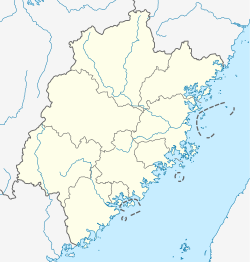Jian'ou
|
Jian'ou 建瓯市 Root Craft City of China |
|
|---|---|
| County-level city | |

Jian'ou Railway Station
|
|
| Nickname(s): 芝城 | |
 Location of Jian'ou City within Nanping City |
|
| Location in Fujian | |
| Coordinates: 27°02′N 118°19′E / 27.033°N 118.317°ECoordinates: 27°02′N 118°19′E / 27.033°N 118.317°E | |
| Country | People's Republic of China |
| Province | Fujian |
| Prefecture-level city | Nanping |
| Government | |
| • CPC City Committee Secretary | Qiu Yi |
| Population | |
| • Total | 452,174 |
| Time zone | China Standard (UTC+8) |
| Local dialect | Northern Min: Jian'ou dialect |
| Website | www.jianou.gov.cn |
| Jian'ou | |||||||||||||
| Traditional Chinese | 建甌 | ||||||||||||
|---|---|---|---|---|---|---|---|---|---|---|---|---|---|
| Simplified Chinese | 建瓯 | ||||||||||||
| Postal | Kienou | ||||||||||||
|
|||||||||||||
| Transcriptions | |
|---|---|
| Standard Mandarin | |
| Hanyu Pinyin | Jiàn'ōu |
| Wade–Giles | Chien4-ou1 |
| Northern Min | |
| Jian'ou Romanized | Gṳ̿ing-é |
Jian'ou (simplified Chinese: 建瓯; traditional Chinese: ; pinyin: Jiàn'ōu; Kienning Romanized: Gṳ̿ing-é) is a county-level city of Nanping in the north of Fujian province, China.
Jian'ou is within a major rice-growing area. It is located on the Jianxi (建溪) Brook, about 70 kilometres (43 mi) south from Jianyang. It is famous as the producing area of bamboo.
Jian'ou was formerly called Kenō, that is, it was the governmental seat of Jianning prefecture. This prefecture and that of Fuzhou were the earliest-established component territories of the province that came to group them, and thus bears their conjoined names: Fu + Jian (福 + 建).
At one time, it was the capital of Fujian. It was the capital of Yin Country in AD 943.
Jian'ou was visited by Marco Polo in 1291, CE, on his way from Hangzhou to Quanzhou. In his account Il Milione, dictated seven years later to a scribe writing in Old French, the name Jianning-fu is romanised Quenlinfu. The city is, he says,
"of considerable size, and contains three very handsome bridges, upwards of a hundred paces in length and eight paces in width. The men of the place are very handsome, and live in a state of luxurious ease. There is much raw silk produced here and it is manufactured into silk pieces of various sorts. Cottons are also woven of coloured threads, which are carried for sale to every part of the province of Mangi. The people employ themselves extensively, and export quantities of ginger and galangal. I have been told, but did not myself see the animal, that there are found at this place a species of domestic fowls which have no feathers, their skins being clothed with black hair, resembling the fur of cats. Such a sight must be extraordinary. They lay eggs like other fowls, and they are good to eat. The multitude of tigers renders traveling through the country dangerous, unless a number of persons go in company."
...
Wikipedia

